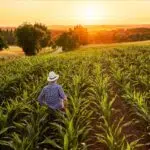Farmer Day, or Dia del Campesino, is celebrated in Peru on June 24 every year as a tribute to the hardworking local farmers that provide food to the table of every Peruvian. Observers celebrate this day by holding agriculture fairs, cultural displays, and of course, the sharing of food. In the Amazonian region, Farmer Day is also celebrated in tandem with the Feast of San Juan Bautista — or St. John the Baptist Day — as a nod to the Catholic tradition that was instilled by Spanish missionaries.
History of Farmer Day
Farmer Day was first established in Peru in 1930 under the name Dia del Indio (Day of the Indian) by then-President Augusto B. Leguia, to honor Peru’s Indigenous people as a whole. The day was renamed Dia del Campesino (Day of the Farmer) by dictator General Juan Velasco Alvarado in 1969. As a bonus, General Alvarado also enacted the Agrarian Reform Law, which helped diversify the country’s land ownership and end forced Indigenous labor.
Currently, agriculture in Peru only makes up around 13% of the country’s gross domestic product. Yet almost a third of the population is employed in the agricultural sector. There are also currently 2.2 million small and medium-sized farms in the country.
Peru’s agricultural production is extremely diversified. The South American Andes region was one of the most prolific places for plant domestication throughout the Neolithic period. To fill their bountiful terrain, the ancient Andeans cultivated and employed about 120 different plant species — which was almost ten times more than other ancient civilizations such as China and Egypt.
As a result, Peru and the neighboring Andean region are noted for their incredible agricultural diversity. It is, for example, one of the world’s greatest producers of artichokes, as well as rice, bananas, grapes, sugarcane, maize, and cassava. Asparagus, avocado, blueberries, potatoes, pineapples, coffee, and cocoa are among the country’s main agricultural exports. Peru’s vital position in the global food supply system is highlighted by the diversity of its output. Thus, Dia del Campesino is important as it is a formal appreciation of Peruvian farmers and agricultural workers and their efforts to preserve the land’s biodiversity and support the economy.
Farmer Day timeline
President Augusto B. Leguia enacts the Peruvian constitution, formally recognizing Peru's Indigenous people as legal entities.
Leguia established The Day of the Indian.
Peruvian dictator Juan Velasco Alvarado renames the holiday Day of the Farmer.
Peru ratifies the International Labor Organization's global Indigenous and Tribal People's Convention, ensuring Indigenous peoples are protected by international law to equality and human rights.
Farmer Day FAQs
How many crops are grown in Peru?
Rice, olives, sugar cane, grapes, apples, yellow corn, potatoes, sweet potatoes, cassava, onions, beans, alfalfa, tomatoes, garlic, and others are all grown.
What are the benefits of being a farmer?
On the economic end, one of the major benefits is that it can help create opportunities to create jobs and lift people out of poverty. Meanwhile, personal benefits include the development of good work ethics, a sense of responsibility, building character, and acquiring a greater appreciation for the land.
Does Peru have quality land for farming?
Peru’s agriculture, while diverse, is not well-integrated. In the more irrigated coasts and river valley areas, up to 1,195,000 hectares have been cultivated for various crops. However, many highland areas, especially on mountain slopes, have very thin and inadequate quality soil. The improper use of land in these areas has also affected the fertility of the soil.
How to Observe Farmer Day
Visit an agricultural fair
Agricultural fairs can be found all around Peru during the day. If you happen to be in Peru for Farmer Day, this is your chance to witness and enjoy the fruits of Peruvian farmers' labor.
Fly the flag
Fly the national flag to showcase your love for Peru and everything it stands for. Farmer Day is a day that celebrates the best of what Peru has to offer, and is a show of appreciation for the people who make it what it is.
Make some Peruvian dishes
Learn some traditional Peruvian recipes and prepare Peruvian cuisine at home. The use of Peru's distinctive crops is the key to a successful Peruvian dinner. After all, there's no better way to honor Peruvian farmers' efforts than to consume some of their produce.
5 Facts About Peruvian Food To Chew On
Peru is famous for its potatoes
Over 3,000 varieties of potatoes are grown in the country.
Guinea pigs are a delicacy
Guinea pig is a staple meat for many Peruvians and contains more protein than llama meat.
The origins of a staple global food
The Lima bean, which originated in Peru, is named after the capital city, Lima.
Their cuisine is a mix of cultures
Many Peruvian recipes are influenced by Chinese, Japanese, and Southeast Asian cuisines, and many national dishes are now considered blends of all of them.
A fruit with a distinctive taste
Peru's authentic lucuma fruit is said to taste like ice cream.
Why Farmer Day is Important
It calls for the respect of Indigenous communities
Farmer Day is a way for Peru to show their appreciation for the roles its Indigenous population and culture have in contributing to the nation's identity and economy. As the original settlers of the land, they deserve to be treated with equal respect as all other people living in the country. Farmer Day is only one of the days Peru has in fulfilling that aim and has been successful in highlighting Indigenous farmers' plights.
It is a way to show appreciation for farmers
Farmers deserve our gratitude for all of their efforts because they play such an essential part in providing us with food. Our stores and markets would be devoid of quality produce if they were not present. A nation's culinary culture would not evolve without them. It is only just that their rights and efforts be honored, regardless of who or what they are.
It highlights the importance and benefits of farming
As more young people are drawn to the promise of working in cities, farming faces an increased risk of stagnation. This could be due to a variety of circumstances, including a lack of job opportunities, low income, or general indifference to what appears to be an outdated way of life. Farmer Day can serve as a rallying point for farmers and agricultural employees to express their concerns to the government to improve conditions and modify attitudes. As a result, future generations will be less deterred by this type of employment.
Farmer Day dates
| Year | Date | Day |
|---|---|---|
| 2026 | June 24 | Wednesday |
| 2027 | June 24 | Thursday |
| 2028 | June 24 | Saturday |
| 2029 | June 24 | Sunday |
| 2030 | June 24 | Monday |


















